oil JEEP CJ 1953 Workshop Manual
[x] Cancel search | Manufacturer: JEEP, Model Year: 1953, Model line: CJ, Model: JEEP CJ 1953Pages: 376, PDF Size: 19.96 MB
Page 57 of 376
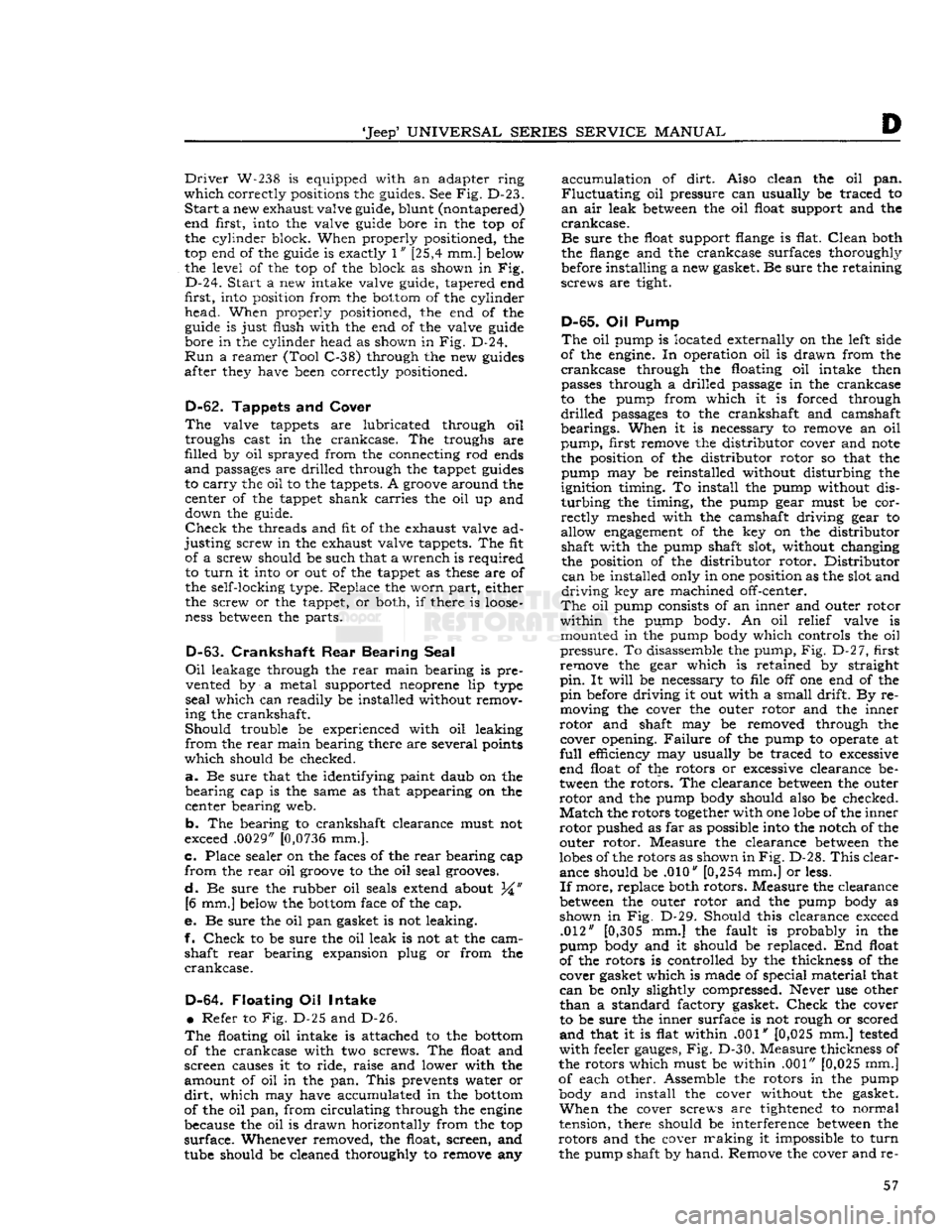
'Jeep5
UNIVERSAL SERIES SERVICE
MANUAL
D
Driver
W-238 is equipped
with
an
adapter
ring
which
correctly positions the guides. See Fig. D-23. Start a new exhaust valve guide, blunt (nontapered)
end
first,
into
the valve guide bore in the top of the cylinder block. When properly positioned, the
top end of the guide is exactly
1
"
[25,4 mm.] below
the level of the top of the block as shown in Fig.
D-24.
Start
a new intake valve guide, tapered end
first, into position from the
bottom
of the cylinder
head.
When properly positioned, the end of the
guide is just flush with the end of the valve guide
bore in the cylinder head as shown in Fig. D-24.
Run
a reamer (Tool
C-3 8)
through the new
guides
after they have been correctly positioned.
D-62. Tappets
and
Cover
The
valve tappets are lubricated through oil troughs cast in the crankcase. The troughs are
filled by oil sprayed from the connecting rod ends
and
passages are drilled through the tappet
guides
to
carry
the oil to the tappets. A
groove
around the center of the tappet shank carries the oil up and down the guide.
Check
the threads and fit of the exhaust valve ad
justing
screw in the exhaust valve tappets. The fit of a screw should be such that a wrench is required to
turn
it into or out of the tappet as
these
are of
the self-locking type. Replace the worn part, either
the screw or the tappet, or both, if there is
loose
ness
between
the parts.
D-63.
Crankshaft Rear Bearing Seal
Oil
leakage through the
rear
main bearing is pre vented by a metal supported neoprene lip type
seal
which can readily be installed without remov
ing the crankshaft.
Should
trouble be experienced with oil leaking
from
the
rear
main bearing there are several points
which
should be checked.
a.
Be sure that the identifying paint daub on the
bearing
cap is the same as that appearing on the
center bearing web.
b.
The bearing to crankshaft clearance must not
exceed .0029"
[0,0736
mm.].
c.
Place sealer on the faces of the
rear
bearing cap
from
the
rear
oil
groove
to the oil seal grooves.
d-
Be sure the rubber oil seals extend about 34" [6 mm.] below the
bottom
face of the cap.
e.
Be sure the oil pan gasket is not leaking.
f.
Check
to be sure the oil leak is not at the cam
shaft
rear
bearing expansion plug or from the
crankcase.
D-64.
Floating Oil
Intake •
Refer to Fig. D-25 and D-26.
The
floating oil intake is attached to the
bottom
of the crankcase with two screws. The float and
screen causes it to ride, raise and lower with the
amount of oil in the pan.
This
prevents water or
dirt,
which
may have accumulated in the
bottom
of the oil pan, from circulating through the
engine
because the oil is drawn horizontally from the top
surface.
Whenever removed, the float, screen, and
tube should be cleaned thoroughly to remove any
accumulation
of
dirt.
Also clean the oil pan.
Fluctuating
oil pressure can usually be traced to
an
air leak
between
the oil float support and the
crankcase.
Be
sure the float support flange is flat.
Clean
both
the flange and the crankcase surfaces thoroughly
before installing a new gasket. Be sure the retaining
screws are tight.
D-65. Oil
Pump
The
oil pump is located externally on the left side
of the engine. In operation oil is drawn from the
crankcase
through the floating oil intake then passes through a drilled passage in the crankcase
to the pump from which it is forced through
drilled
passages to the crankshaft and camshaft
bearings. When it is necessary to remove an oil
pump,
first remove the distributor cover and
note
the position of the distributor rotor so that the pump may be reinstalled without disturbing the
ignition timing. To install the pump without dis
turbing
the timing, the pump gear must be cor
rectly
meshed with the camshaft driving gear to
allow
engagement
of the key on the distributor shaft with the pump shaft slot, without changing the position of the distributor rotor. Distributor
can
be installed only in one position as the slot and
driving
key are machined off-center.
The
oil pump consists of an inner and outer rotor
within
the pump body. An oil relief valve is mounted in the pump body which controls the oil
pressure.
To disassemble the pump, Fig. D-27, first remove the gear which is retained by straight
pin.
It
will
be necessary to file off one end of the
pin
before driving it out with a small drift. By re
moving the cover the outer rotor and the inner
rotor
and shaft may be removed through the cover opening.
Failure
of the pump to operate at
full
efficiency may usually be traced to excessive
end float of the rotors or excessive clearance be tween the rotors. The clearance
between
the outer
rotor
and the pump body should also be checked.
Match
the rotors
together
with one
lobe
of the inner
rotor
pushed as far as possible into the notch of the outer rotor. Measure the clearance
between
the
lobes
of the rotors as shown in
Fig.
D-28.
This
clear ance should be .010"
[0,254
mm.] or less.
If
more, replace both rotors. Measure the clearance
between
the outer rotor and the pump body as
shown in Fig. D-29. Should this clearance exceed .012" [0,305 mm.] the fault is probably in the
pump body and it should be replaced. End float
of the rotors is controlled by the thickness of the cover gasket which is made of special material that
can
be only slightly compressed. Never use other
than
a standard factory gasket.
Check
the cover
to be sure the inner surface is not rough or scored
and
that it is flat within .001" [0,025 mm.]
tested
with
feeler
gauges,
Fig. D-30. Measure thickness of
the rotors which must be within .001" [0,025 mm.]
of each other. Assemble the rotors in the pump body and install the cover without the gasket.
When
the cover screws are tightened to normal
tension, there should be interference
between
the
rotors and the cover making it impossible to
turn
the pump shaft by hand. Remove the cover and re- 57
Page 58 of 376
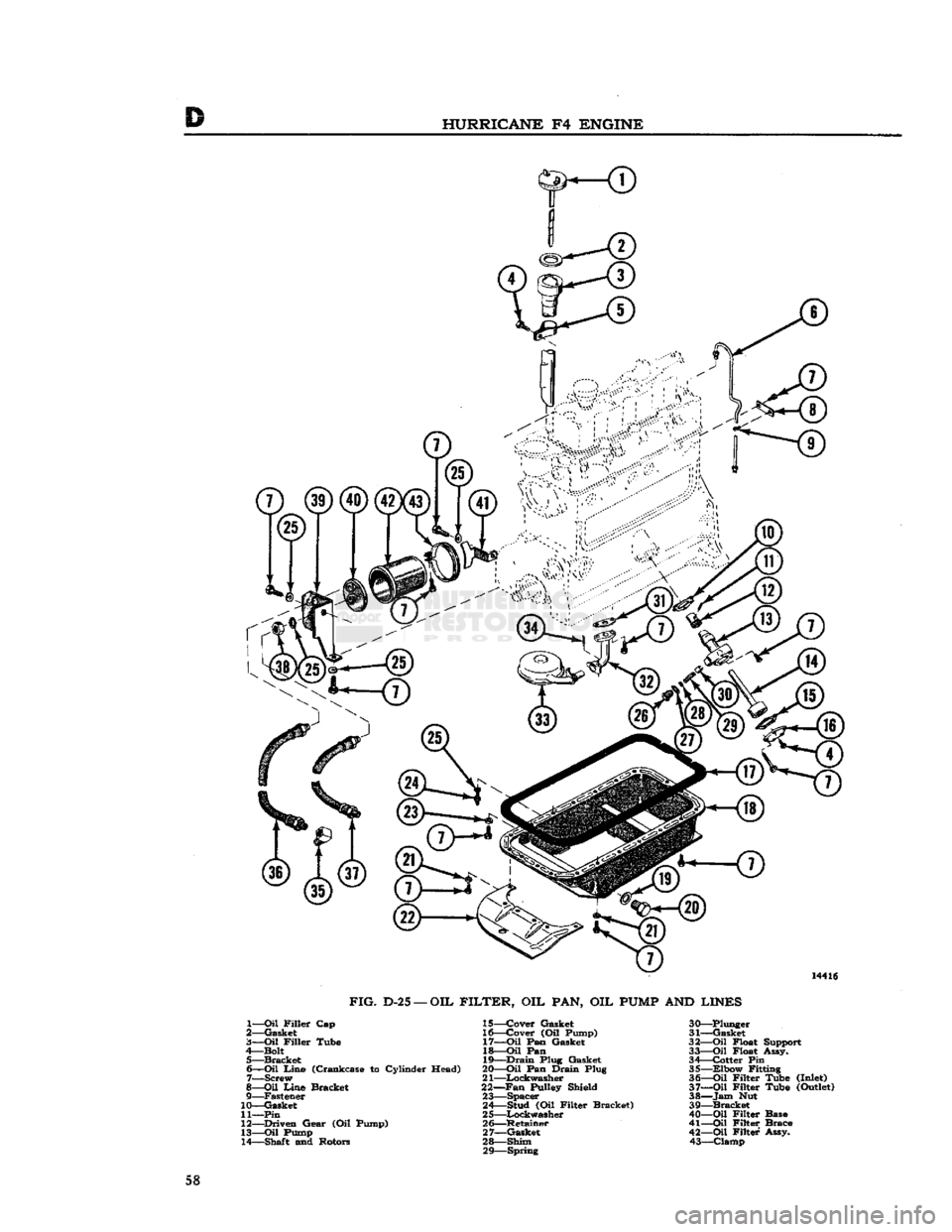
HURRICANE
F4
ENGINE
FIG.
D-2
5
—
OIL
FILTER,
OIL PAN, OIL PUMP AND
LINES
1—
Oil
Filler Cap
2— Gasket
3—Oil
Filler Tube
4—Bolt
5— Bracket 6—
Oil
Line (Crankcase to Cylinder Head) 7— Screw
8—
Oil
Line Bracket
9— ^Fastener
10— Gasket
11—
Pin
12— Driven Gear (Oil Pump)
13—
Oil
Pump
14— Shaft and Rotors 15— Cover Gasket
16— -Cover (Oil Pump)
17—
Oil
Pan Gasket
18—
Oil
Pan 19—
Drain
Plug Gasket
20—
Oil
Pan Drain Plug
21— Lockwasher
22—
Fan
Pulley Shield 23— Spacer 24— Stud (Oil Filter Bracket)
25— Lockwasher 26— Retainer
27— Gasket
28— Shim 29— Spring 30— Plunger
31— Gasket
32—
Oil
Float Support 33—
Oil
Float Assy.
34— Cotter Pin
35— Elbow Fitting 36—
Oil
Filter Tube (Inlet)
37—
Oil
Filter Tube (Outlet)
38—
Jam
Nut
39— Bracket
40—
Oil
Filter Base 41—
Oil
Filter Brace
42—
Oil
Filter Assy.
43— Clamp 58
Page 59 of 376
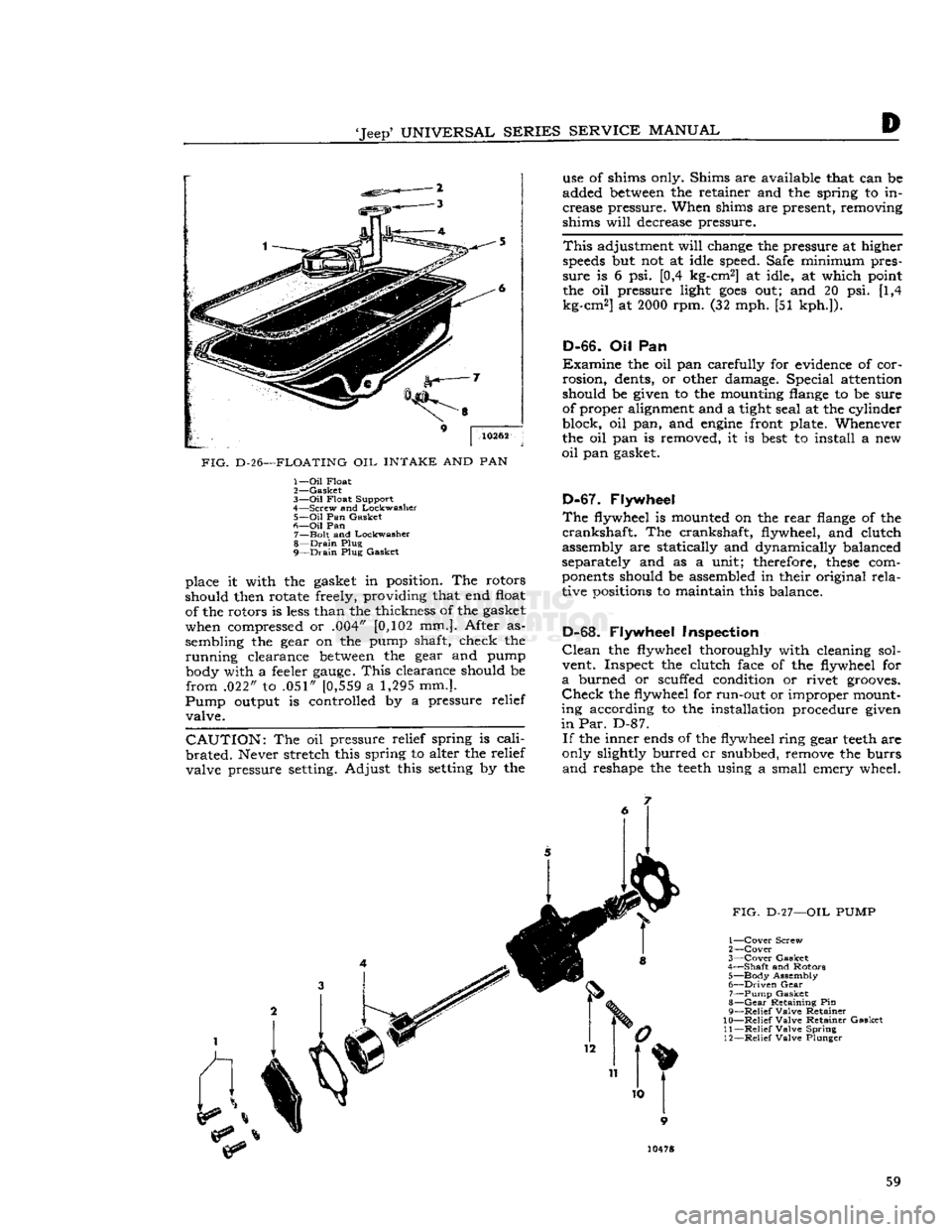
'Jeep*
UNIVERSAL SERIES SERVICE
MANUAL
D
10262
FIG.
D-26—FLOATING OIL INTAKE AND PAN 1—
Oil
Float
2—
Gasket
3—
Oil
Float Support
4—
Screw and Lockwasher 5—
Oil
Pan Gasket
6—
Oil
Pan 7—
Bolt
and Lockwasher
8—
Drain
Plug
9—
Drain
Plug Gasket
place it with the gasket in position. The rotors
should then rotate freely, providing that end float of the rotors is
less
than the thickness of the gasket
when compressed or .004" [0,102 mm.]. After as
sembling the gear on the pump shaft, check the
running
clearance
between
the gear and pump body with a feeler
gauge.
This
clearance should be
from
.022" to .051" [0,559 a 1,295 mm.].
Pump
output is controlled by a pressure relief valve.
CAUTION:
The oil pressure relief spring is
cali
brated.
Never stretch this spring to alter the relief valve pressure setting. Adjust this setting by the use of shims only. Shims are available that can be
added
between
the retainer and the spring to in
crease pressure. When shims are present, removing
shims
will
decrease pressure.
This
adjustment
will
change the pressure at higher
speeds
but not at idle speed. Safe minimum pres
sure
is 6 psi. [0,4 kg-cm2] at idle, at which point
the oil pressure light
goes
out; and 20 psi. [1,4
kg-cm2] at
2000
rpm. (32 mph. [51 kph.]).
D-66.
Oil Pan
Examine
the oil pan carefully for evidence of cor
rosion,
dents, or other damage. Special attention
should be given to the mounting flange to be sure of proper alignment and a tight seal at the cylinder
block, oil pan, and
engine
front plate. Whenever
the oil pan is removed, it is
best
to install a new
oil
pan gasket.
D-67.
Flywheel
The
flywheel is mounted on the
rear
flange of the
crankshaft.
The crankshaft, flywheel, and clutch
assembly are statically and dynamically balanced
separately and as a unit; therefore,
these
com
ponents
should be assembled in their original
rela
tive positions to maintain this balance.
D-68.
Flywheel Inspection
Clean
the flywheel thoroughly with cleaning sol vent. Inspect the clutch face of the flywheel for
a
burned or scuffed condition or rivet grooves.
Check
the flywheel for run-out or improper mount
ing according to the installation procedure given
in Par.
D-87.
If
the inner ends of the flywheel ring gear
teeth
are
only slightly burred cr snubbed, remove the burrs
and
reshape the
teeth
using a small emery wheel. 59
Page 60 of 376
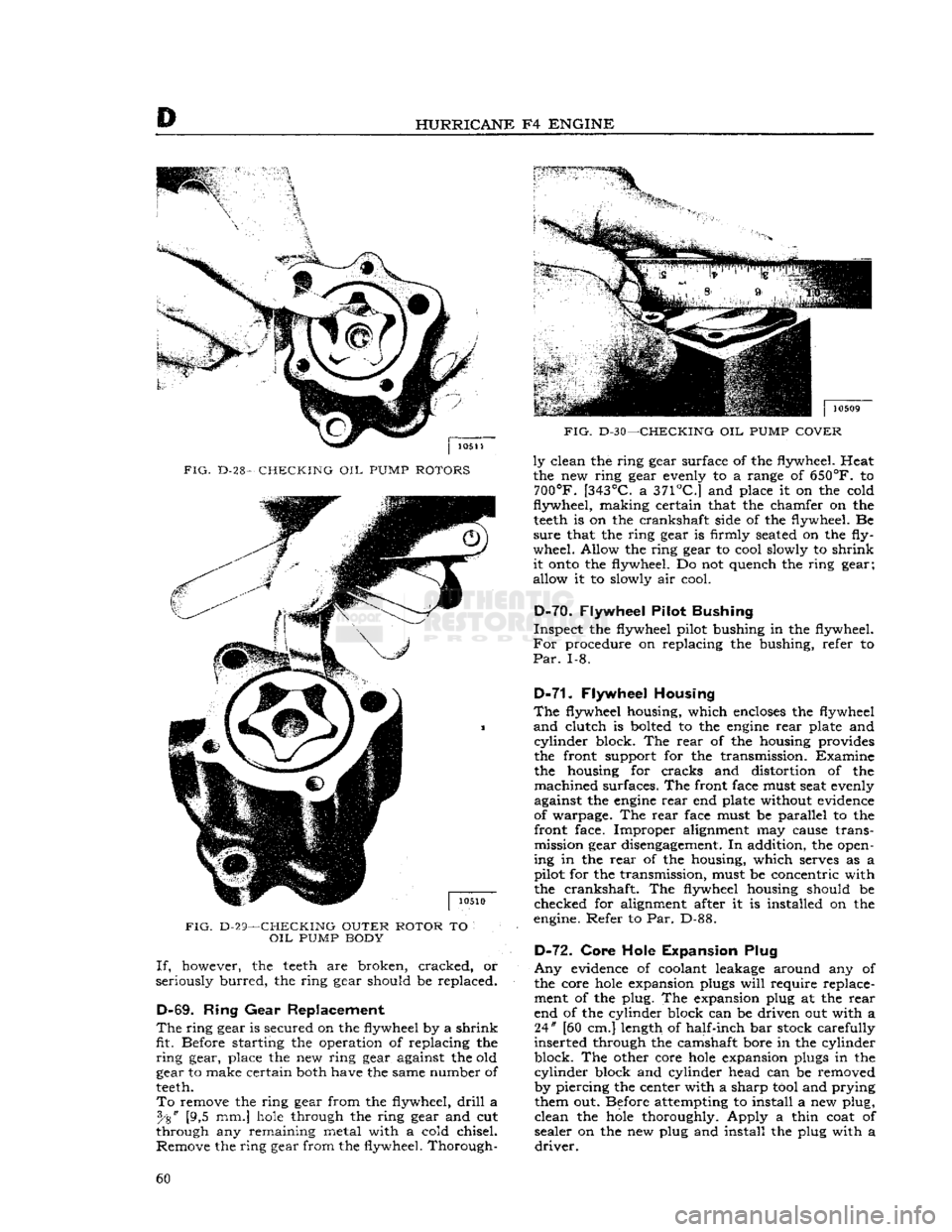
HURRICANE
F4
ENGINE
FIG.
D-28-
CHECKING
OIL
PUMP
ROTORS
FIG.
D-29—CHECKING OUTER ROTOR
TO
OIL
PUMP
BODY If,
however, the
teeth
are broken, cracked, or
seriously
burred,
the ring gear should be replaced.
D-69.
Ring
Gear
Replacement
The
ring
gear
is secured on the flywheel by a
shrink
fit. Before starting the operation of replacing the
ring
gear, place the new ring gear against the old
gear to make certain both have the same number of
teeth.
To
remove the ring gear from the flywheel,
drill
a [9,5 mm.]
hole
through the ring gear and cut
through any remaining metal with a cold chisel. Remove the ring gear from the flywheel. Thorough-
FIG.
D-30—CHECKING
OIL
PUMP
COVER
ly
clean the ring gear surface of the flywheel. Heat
the new ring gear evenly to a range of
650°F.
to
700°F.
[343°C.
a
371°C.]
and place it on the cold
flywheel,
making
certain that the chamfer on the
teeth
is on the crankshaft side of the flywheel. Be
sure
that the ring gear is firmly seated on the fly
wheel. Allow the ring gear to cool slowly to
shrink
it
onto
the flywheel. Do not quench the ring gear;
allow it to slowly air cool.
D-7Q.
Flywheel Pilot Bushing
Inspect
the flywheel pilot bushing in the flywheel.
For
procedure on replacing the bushing, refer to
Par.
1-8.
D-71.
Flywheel Housing
The
flywheel housing, which
encloses
the flywheel
and
clutch is bolted to the
engine
rear
plate and
cylinder
block. The
rear
of the housing provides
the front support for the transmission. Examine the housing for cracks and distortion of the
machined
surfaces. The front face must seat evenly
against the
engine
rear
end plate without evidence
of warpage. The
rear
face must be parallel to the front face. Improper alignment may cause transmission gear disengagement. In addition, the open
ing in the
rear
of the housing, which serves as a
pilot for the transmission, must be concentric with the crankshaft. The flywheel housing should be
checked for alignment after it is installed on the
engine. Refer to Par. D-88.
D-72.
Core Hole Expansion Plug
Any
evidence of coolant leakage around any of
the core
hole
expansion plugs
will
require replace ment of the plug. The expansion plug at the
rear
end of the cylinder block can be driven out with a 24" [60 cm.] length of half-inch bar stock carefully
inserted through the camshaft bore in the cylinder
block. The other core
hole
expansion plugs in the
cylinder
block and cylinder head can be removed
by piercing the center with a sharp tool and prying them out. Before attempting to install a new plug,
clean
the
hole
thoroughly. Apply a thin coat of
sealer on the new plug and install the plug with a
driver.
60
Page 61 of 376
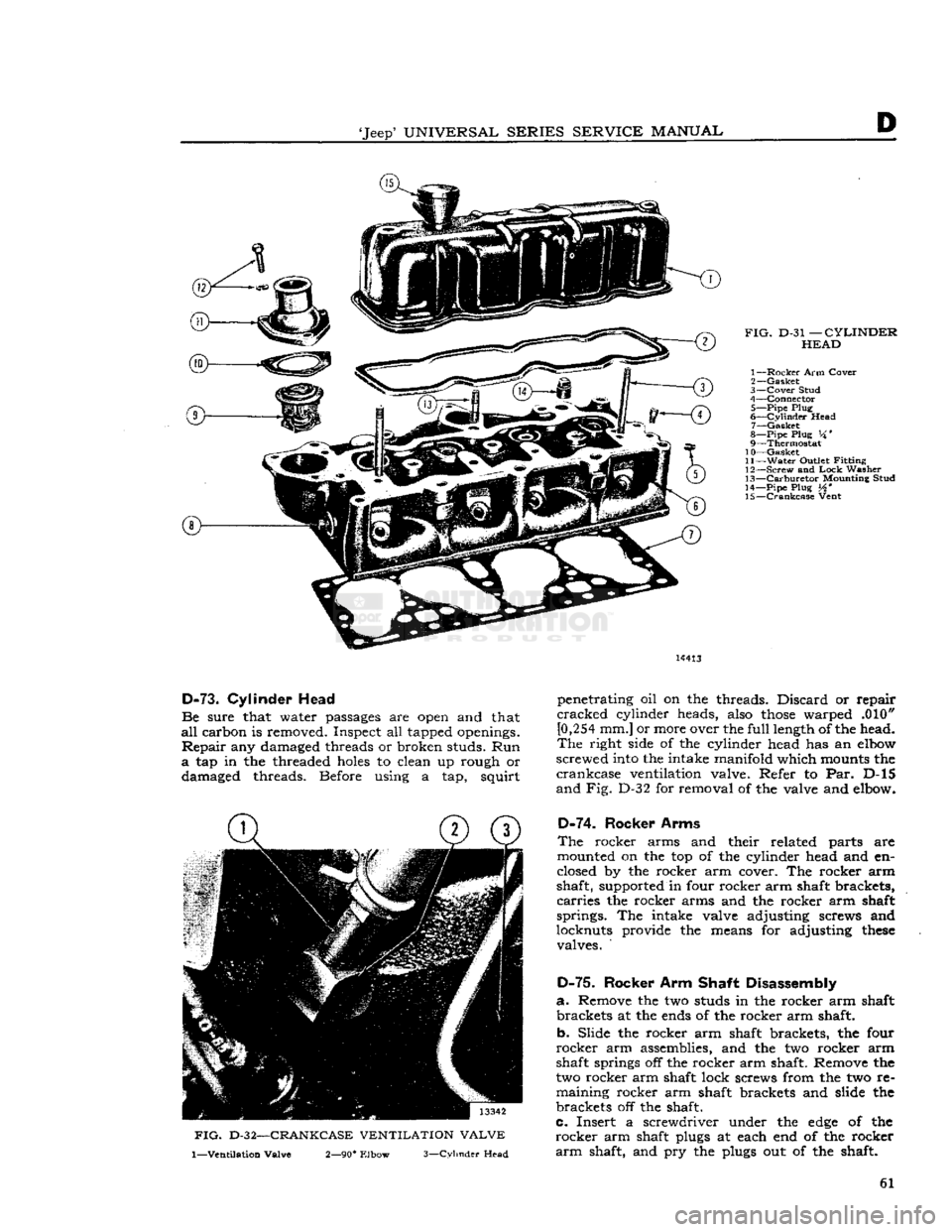
'Jeep'
UNIVERSAL
SERIES SERVICE
MANUAL
FIG.
D-31
—
CYLINDER
HEAD
1—
Rocker
Arm
Cover
2—
Gasket
3—
Cover
Stud
4—
Connector
5—
Pipe
Plug
6—
Cylinder
Head
7—
Gasket
8—
Pipe
Plug
H'
9—
Thermostat
10—
Gasket
11—
Water
Outlet
Fitting
12—
Screw
and
Lock
Washer
13—
Carburetor
Mounting
Stud
14—
Pipe
Plug
H"
15—
Crankcase
Vent
14413
D-73.
Cylinder Head
Be
sure that water
passages
are
open
and that
all
carbon is removed. Inspect all tapped
openings.
Repair
any damaged threads or broken studs. Run
a
tap in the threaded
holes
to clean up rough or
damaged threads. Before using a tap, squirt penetrating oil on the threads.
Discard
or repair
cracked
cylinder heads, also
those
warped .010"
[0,254
mm.] or more over the
full
length of the head.
The
right side of the cylinder head has an
elbow
screwed
into
the intake manifold which mounts the
crankcase
ventilation valve. Refer to Par. D-l5
and
Fig. D-32 for removal of the valve and
elbow.
13342
FIG.
D-32—CRANKCASE VENTILATION
VALVE
1—Ventilation
Valve
2—90*
Elbow
3—Cylinder
Head
D-74.
Rocker Arms
The
rocker arms and their related parts are
mounted on the top of the cylinder head and en
closed by the rocker arm cover. The rocker arm
shaft, supported in four rocker arm shaft brackets,
carries
the rocker arms and the rocker arm shaft
springs.
The intake valve adjusting screws and
locknuts provide the means for adjusting
these
valves.
D-75.
Rocker
Arm
Shaft Disassembly
a.
Remove the two studs in the rocker arm shaft
brackets
at the
ends
of the rocker arm shaft.
b.
Slide the rocker arm shaft brackets, the four
rocker
arm assemblies, and the two rocker arm
shaft springs off the rocker arm shaft. Remove the
two rocker arm shaft lock screws from the two re
maining
rocker arm shaft brackets and slide the
brackets
off the shaft.
c.
Insert a screwdriver under the
edge
of the
rocker
arm shaft plugs at each end of the rocker
arm
shaft, and pry the plugs out of the shaft. 61
Page 62 of 376
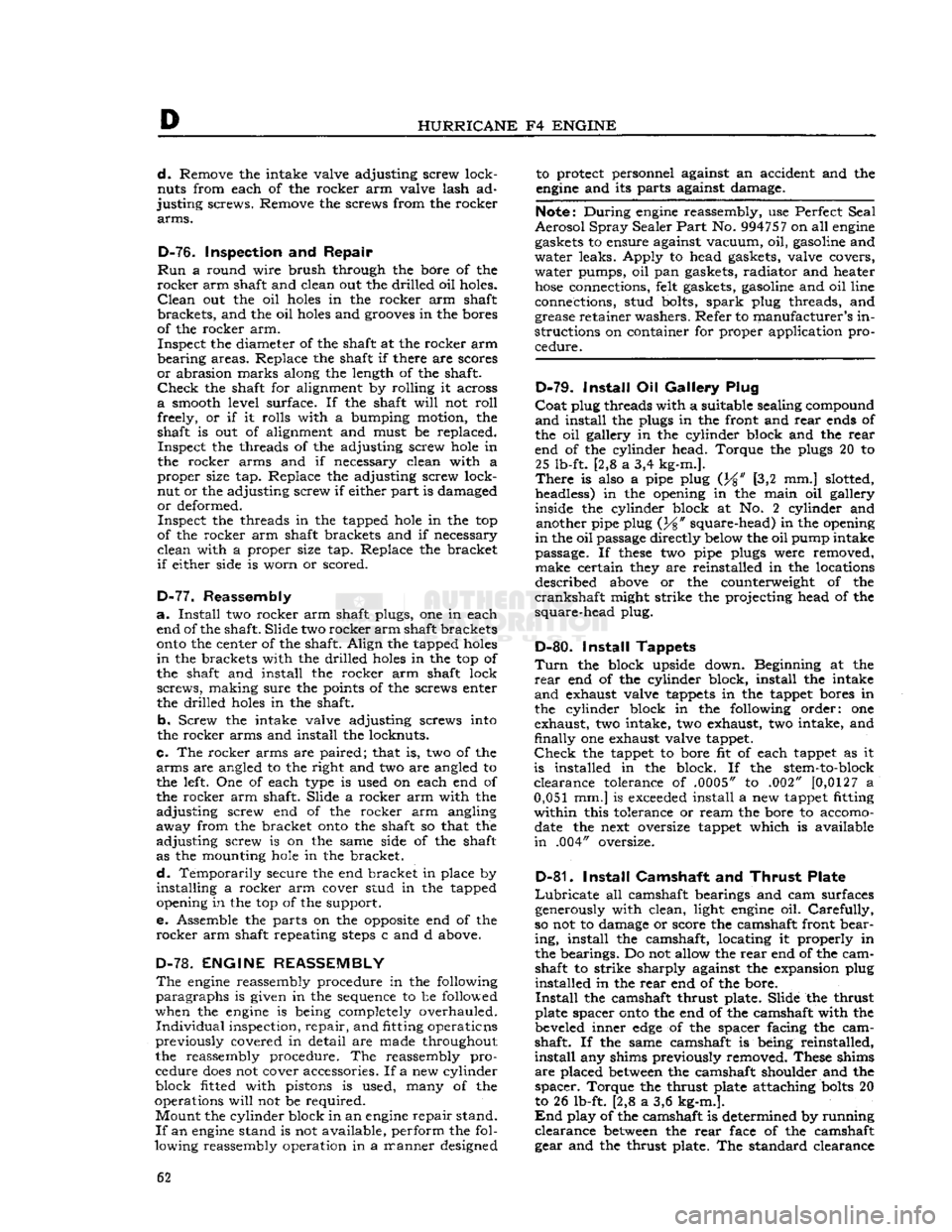
D
HURRICANE
F4
ENGINE d.
Remove the intake valve adjusting screw lock-
nuts from each of the rocker arm valve lash ad
justing
screws. Remove the screws from the rocker
arms.
D-76.
Inspection and
Repair
Run
a round wire brush through the bore of the
rocker
arm shaft and clean out the drilled oil holes.
Clean
out the oil
holes
in the rocker arm shaft
brackets,
and the oil
holes
and
grooves
in the bores
of the rocker arm.
Inspect
the diameter of the shaft at the rocker arm
bearing
areas. Replace the shaft if there are scores
or
abrasion marks along the length of the shaft.
Check
the shaft for alignment by rolling it across
a
smooth level surface. If the shaft
will
not
roll
freely, or if it rolls with a bumping motion, the
shaft is out of alignment and must be replaced.
Inspect
the threads of the adjusting screw
hole
in
the rocker arms and if necessary clean with a
proper
size tap. Replace the adjusting screw lock-
nut or the adjusting screw if either part is damaged
or
deformed.
Inspect
the threads in the tapped
hole
in the top
of the rocker arm shaft brackets and if necessary
clean
with a proper size tap. Replace the bracket
if
either side is worn or scored.
D-77.
Reassembly
a.
Install
two rocker arm shaft plugs, one in each
end of the shaft. Slide two
rocker
arm
shaft brackets
onto
the center of the shaft. Align the tapped
holes
in
the brackets with the drilled
holes
in the top of
the shaft and install the rocker arm shaft lock
screws,
making sure the points of the screws enter
the drilled
holes
in the shaft.
b.
Screw the intake valve adjusting screws into
the rocker arms and install the locknuts.
c.
The rocker arms are paired; that is, two of the
arms
are angled to the right and two are angled to
the left. One of each type is used on each end of
the rocker arm shaft. Slide a rocker arm with the
adjusting
screw end of the rocker arm angling
away
from the bracket
onto
the shaft so that the
adjusting
screw is on the same side of the shaft
as the mounting
hole
in the bracket.
d.
Temporarily
secure the end bracket in place by
installing
a rocker arm cover stud in the tapped
opening in the top of the support.
e. Assemble the parts on the
opposite
end of the
rocker
arm shaft repeating
steps
c and d above.
D-78. ENGINE REASSEMBLY
The
engine
reassembly procedure in the following
paragraphs
is given in the sequence to be followed
when the
engine
is being completely overhauled.
Individual
inspection,
repair,
and fitting operations
previously covered in detail are made throughout
the reassembly procedure. The reassembly pro
cedure
does
not cover accessories. If a new cylinder
block
fitted with pistons is used, many of the
operations
will
not be required.
Mount
the cylinder block in an
engine
repair stand.
If
an
engine
stand is not available, perform the fol
lowing reassembly operation in a manner designed to protect personnel against an accident and the
engine
and its parts against damage.
Note:
During
engine
reassembly, use Perfect Seal
Aerosol
Spray
Sealer
Part
No.
994757
on all
engine
gaskets to ensure against vacuum, oil, gasoline and
water
leaks. Apply to head gaskets, valve covers,
water
pumps, oil pan gaskets, radiator and heater
hose
connections, felt gaskets, gasoline and oil line
connections, stud bolts,
spark
plug threads, and
grease retainer washers. Refer to manufacturer's in
structions on container for proper application pro
cedure.
D-79.
Install
Oil
Gallery
Plug
Coat
plug threads with a suitable sealing compound
and
install the plugs in the front and
rear
ends of
the oil gallery in the cylinder block and the
rear
end of the cylinder head. Torque the plugs 20 to 25 lb-ft. [2,8 a 3,4 kg-m.].
There
is also a pipe plug
(}/g,f
[3,2 mm.] slotted, headless) in the opening in the main oil gallery inside the cylinder block at No. 2 cylinder and another pipe plug
(}/g
"
square-head) in the opening
in
the oil passage directly below the oil pump intake
passage. If
these
two pipe plugs were removed,
make
certain they are reinstalled in the locations
described above or the counterweight of the
crankshaft
might strike the projecting head of the
square-head
plug.
D-80.
Install
Tappets
Turn
the block upside down. Beginning at the
rear
end of the cylinder block, install the intake
and
exhaust valve tappets in the tappet bores in the cylinder block in the following order: one
exhaust, two intake, two exhaust, two intake, and
finally
one exhaust valve tappet.
Check
the tappet to bore fit of each tappet as it
is installed in the block. If the stem-to-block
clearance
tolerance of .0005" to .002" [0,0127 a
0,051 mm.] is
exceeded
install a new tappet fitting
within
this tolerance or ream the bore to accomo date the next oversize tappet which is available
in
.004" oversize.
D-81.
Install
Camshaft and
Thrust
Plate
Lubricate
all camshaft bearings and cam surfaces generously with clean, light
engine
oil.
Carefully,
so not to damage or score the camshaft front bear
ing,
install the camshaft, locating it properly in the bearings. Do not allow the
rear
end of the camshaft to strike sharply against the expansion plug
installed
in the
rear
end of the bore.
Install
the camshaft thrust plate. Slide the thrust
plate spacer
onto
the end of the camshaft with the
beveled inner
edge
of the spacer facing the cam
shaft. If the same camshaft is being reinstalled,
install
any shims previously removed. These shims
are
placed
between
the camshaft shoulder and the
spacer.
Torque the thrust plate attaching
bolts
20
to 26 lb-ft. [2,8 a 3,6 kg-m.].
End
play of the camshaft is determined by running
clearance
between
the
rear
face of the camshaft
gear and the thrust plate. The standard clearance 62
Page 63 of 376
![JEEP CJ 1953 Workshop Manual
Jeep
UNIVERSAL SERIES SERVICE
MANUAL
D
is .004" to .007"
[0,102
a 0,178 mm.] as measured
by a dial indicator. Should a check
show
too little
end play, place a shim of suitable thickness
JEEP CJ 1953 Workshop Manual
Jeep
UNIVERSAL SERIES SERVICE
MANUAL
D
is .004" to .007"
[0,102
a 0,178 mm.] as measured
by a dial indicator. Should a check
show
too little
end play, place a shim of suitable thickness](/img/16/57040/w960_57040-62.png)
'Jeep'
UNIVERSAL SERIES SERVICE
MANUAL
D
is .004" to .007"
[0,102
a 0,178 mm.] as measured
by a dial indicator. Should a check
show
too little
end play, place a shim of suitable thickness
between
the camshaft shoulder and the spacer. Too much
end play may be corrected by removing shims or
dressing off the spacer a slight amount. See Fig. D-33.
D-82. Install Crankshaft and Bearings
Fit
the three upper main bearings
into
their
respective
locations
in the cylinder block. Fit the
three lower main bearings
into
their respective
bearing caps.
NOTE:
It is
possible
to incorrectly install the front main bearing. The bearing is properly installed in
the cap with the narrower of the two radial oil
grooves
toward the front
edge
of the cap. If this
bearing is not properly installed, the oil
grooves
in
the two halves of the bearing will not match at the
parting line and premature failure of the bearing
will
result.
Lubricate
all bearing surfaces
generously
with
clean, light
engine
oil. Place the crankshaft in
position
in the cylinder block and install the main
bearing caps. Torque the
bolts
65 to 75 lb-ft.
[9,0 a 10,4 kg-m.] rotating the crankshaft after
each bearing cap is
tightened
D-83. Check Crankshaft End-Play
End
play of the crankshaft is set by the running
clearance
between
the crankshaft thrust washer
and the front
face
of the front main bearing. The
standard end play is .004" to .006"
[0,102
a 0,152
mm.] which is controlled by .002"
[0,051
mm.]
shims placed
between
the thrust washer and the
shoulder on the crankshaft. Check the end play
with a dial indicator as shown in
Fig.
D-34. If clear ance is incorrect, adjustment is made by adding or
removing shims.
Install
the thrust washer with the
beveled
inner
edge
toward the front bearing.
10668
FIG.
D-33—VALVES, CAMSHAFT,
AND
TIMING GEARS
1— Nut
2—
Left
Rocker Arm
3—
Rocker
Arm Shaft Spring
4—
Rocker
Shaft
Lock
Screw 5—
Rocker
Shaft
6— Nut 7—
Right
Rocker Arm
8—
Rocker
Arm Shaft Bracket
9—
Intake
Valve Tappet Adjusting Screw
10—
Intake
Valve Upper Retainer
Lock
11—
Oil
Seal
12—
Intake
Valve Spring Upper Retainer 13—
Intake
Valve Spring
14—
Intake
Valve Push Rod 15—
Intake
Valve
16—
Intake
Valve Tappet
17—
Camshaft
18—
Camshaft
Front Bearing
19—
Camshaft
Thrust Plate Spacer
20—
Camshaft
Thrust Plate
21— Bolt and Lockwasher
22— Bolt 13—Lockwasher
24—Camshaft
Gear
Washer 25—
Crankshaft
Gear
26—
Camshaft
Gear
27— Woodruff Key No. 9
28—
Exhaust
Valve Tappet
29— Tappet Adjusting Screw
30—
Spring
Retainer
Lock
31— Roto Cap Assembly
32—
Exhaust
Valve Spring
33—
Exhaust
Valve
34—
Rocker
Shaft Support Stud
35—
Washer
36—
Rocker
Arm Cover Stud 63
Page 64 of 376
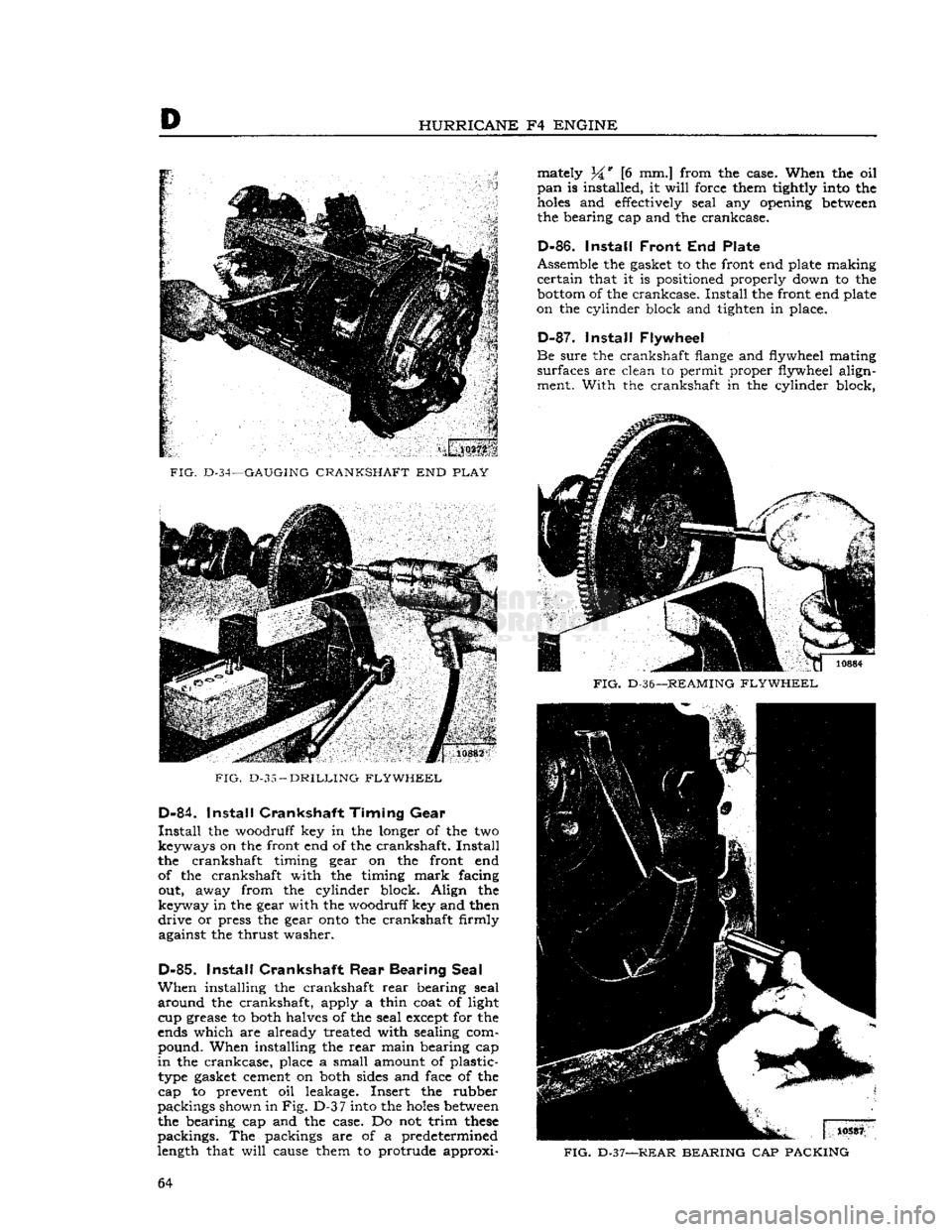
D
HURRICANE
F4
ENGINE
FIG.
D-34—GAUGING
CRANKSHAFT
END
PLAY
FIG.
D-35
—
DRILLING FLYWHEEL
D-84.
Install
Crankshaft Timing
Gear
Install
the woodruff key in the longer of the two keyways on the front end of the crankshaft.
Install
the crankshaft timing gear on the front end of the crankshaft with the timing
mark
facing out, away from the cylinder block. Align the
keyway in the gear with the woodruff key and then
drive
or press the gear
onto
the crankshaft firmly against the thrust washer.
D-85.
Install
Crankshaft
Rear
Bearing Seal
When
installing the crankshaft
rear
bearing seal
around
the crankshaft, apply a thin coat of light cup grease to both halves of the seal except for the
ends which are already treated with sealing com pound. When installing the
rear
main bearing cap
in
the crankcase, place a small amount of plastic- type gasket cement on both sides and face of the
cap to prevent oil leakage. Insert the rubber
packings shown in
Fig. D-3
7
into the
holes
between
the bearing cap and the case. Do not trim
these
packings. The packings are of a predetermined
length that
will
cause them to protrude approxi mately 34* [6 mm.] from the case. When the oil
pan
is installed, it
will
force them tightly into the
holes
and effectively seal any opening
between
the bearing cap and the crankcase.
D-86.
Install
Front
End Plate
Assemble the gasket to the front end plate making
certain
that it is positioned properly down to the
bottom
of the crankcase.
Install
the front end plate
on the cylinder block and tighten in place.
D-87.
Install
Flywheel
Be
sure the crankshaft flange and flywheel mating
surfaces are clean to permit proper flywheel align ment. With the crankshaft in the cylinder block,
FIG.
D-36—
REAMING FLYWHEEL
FIG.
D-37—REAR
BEARING
CAP
PACKING
64
Page 65 of 376
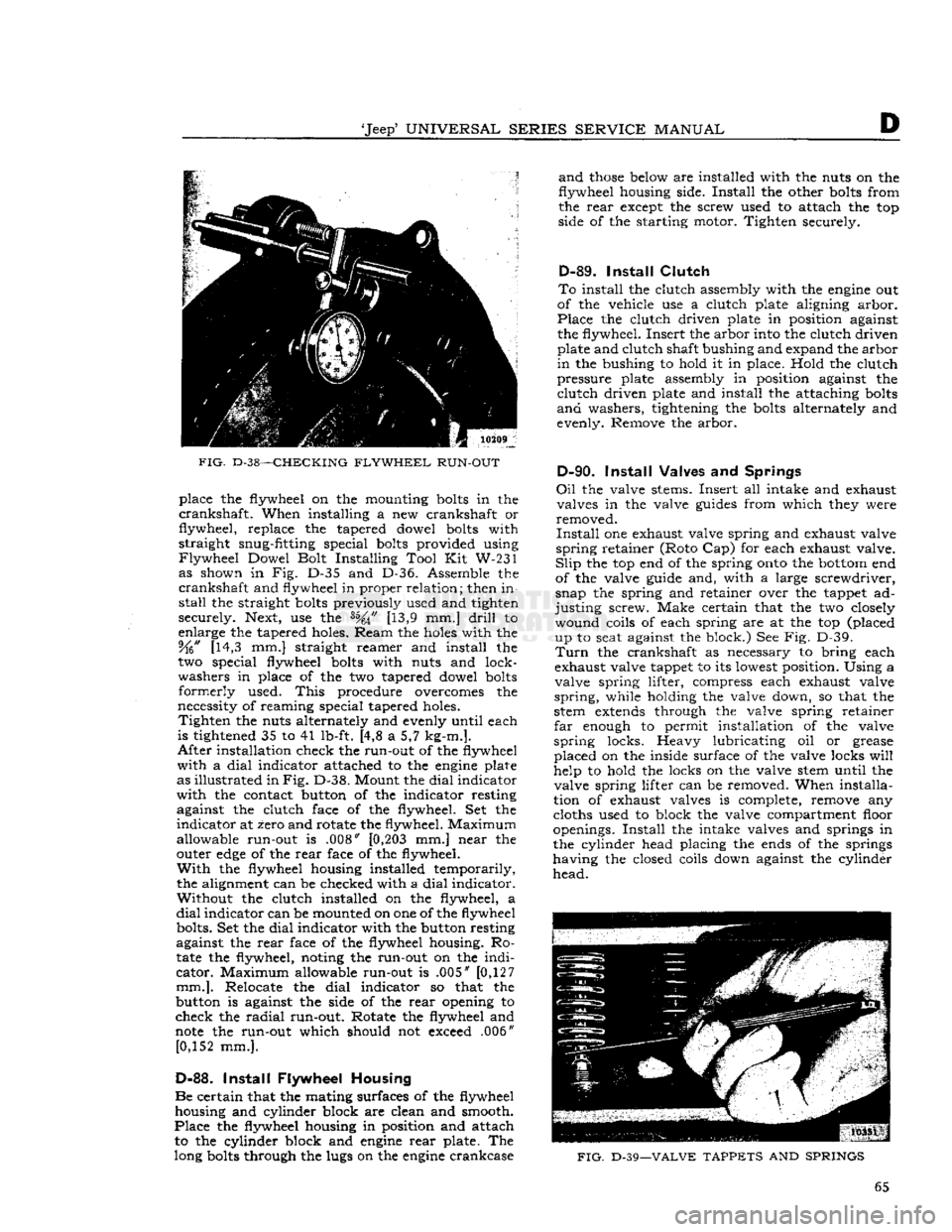
'Jeep'
UNIVERSAL
SERIES
SERVICE
MANUAL
D
FIG.
D-38—CHECKING
FLYWHEEL
RUN-OUT
place the flywheel on the mounting
bolts
in the
crankshaft.
When installing a new crankshaft or
flywheel, replace the tapered dowel
bolts
with
straight snug-fitting special
bolts
provided using
Flywheel
Dowel Bolt Installing Tool Kit W-231 as shown in Fig. D-35 and D-36. Assemble the
crankshaft
and flywheel in proper relation; then in
stall
the straight
bolts
previously used and tighten
securely. Next, use the [13,9 mm.]
drill
to
enlarge the tapered holes. Ream the
holes
with the 5fo" [14,3 mm.] straight reamer and install the
two special flywheel
bolts
with nuts and lock
washers in place of the two tapered dowel
bolts
formerly
used.
This
procedure overcomes the
necessity of reaming special tapered holes.
Tighten
the nuts alternately and evenly until each
is tightened 35 to 41 lb-ft. [4,8 a 5,7 kg-m.].
After
installation check the run-out of the flywheel
with
a
dial
indicator attached to the
engine
plate
as illustrated in
Fig.
D-38. Mount the
dial
indicator
with
the contact button of the indicator resting against the clutch face of the flywheel. Set the
indicator
at zero and rotate the flywheel. Maximum
allowable run-out is .008"
[0,203
mm.] near the
outer
edge
of the
rear
face of the flywheel.
With
the flywheel housing installed temporarily,
the alignment can be checked with a
dial
indicator. Without the clutch installed on the flywheel, a
dial
indicator can be mounted on one of the flywheel bolts. Set the
dial
indicator with the button resting
against the
rear
face of the flywheel housing. Ro
tate
the flywheel, noting the run-out on the
indi
cator.
Maximum allowable run-out is .005" [0,127
mm.].
Relocate the
dial
indicator so that the
button is against the side of the
rear
opening to
check the
radial
run-out. Rotate the flywheel and
note
the run-out which should not exceed .006" [0,152 mm.].
D-88.
Install
Flywheel Housing
Be
certain that the mating surfaces of the flywheel housing and cylinder block are clean and smooth.
Place
the flywheel housing in position and attach to the cylinder block and
engine
rear
plate. The
long
bolts
through the lugs on the
engine
crankcase
and
those
below are installed with the nuts on the
flywheel housing side.
Install
the other
bolts
from
the
rear
except the screw used to attach the top
side of the starting motor. Tighten securely.
D-89.
Install
Clutch
To
install the clutch assembly with the
engine
out
of the vehicle use a clutch plate aligning arbor.
Place
the clutch driven plate in position against
the flywheel. Insert the arbor into the clutch driven plate and clutch shaft bushing and expand the arbor
in
the bushing to hold it in place. Hold the clutch
pressure plate assembly in position against the
clutch
driven plate and install the attaching
bolts
and
washers, tightening the
bolts
alternately and
evenly. Remove the arbor.
D-90.
Install
Valves and Springs
Oil
the valve stems. Insert all intake and exhaust valves in the valve
guides
from which they were
removed.
Install
one exhaust valve spring and exhaust valve
spring
retainer (Roto Cap) for each exhaust valve.
Slip
the top end of the spring
onto
the
bottom
end
of the valve guide and, with a large screwdriver,
snap the spring and retainer over the tappet ad
justing
screw. Make certain that the two closely wound coils of each spring are at the top (placed up to seat against the block.) See Fig. D-39.
Turn
the crankshaft as necessary to bring each
exhaust valve tappet to its lowest position. Using a
valve spring lifter, compress each exhaust valve
spring,
while holding the valve down, so that the
stem
extends
through the valve spring retainer
far
enough to permit installation of the valve
spring
locks. Heavy lubricating oil or grease
placed on the inside surface of the valve locks
will
help to hold the locks on the valve stem until the valve spring lifter can be removed. When installa
tion of exhaust valves is complete, remove any
cloths used to block the valve compartment floor
openings.
Install
the intake valves and springs in the cylinder head placing the ends of the springs
having the closed coils down against the cylinder
head.
FIG.
D-39—VALVE
TAPPETS
AND
SPRINGS
65
Page 66 of 376
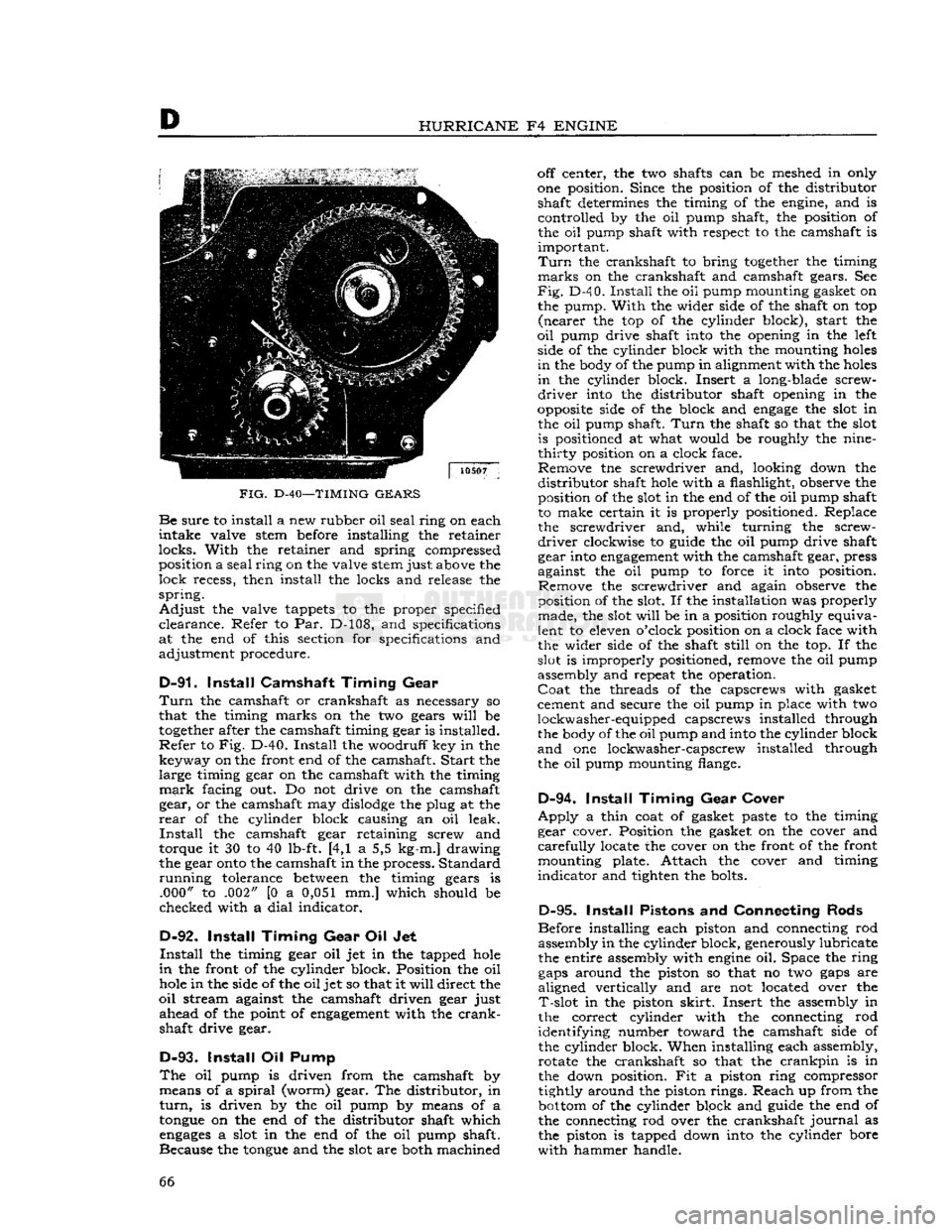
D
HURRICANE
F4
ENGINE
FIG.
D-40—TIMING
GEARS Be
sure
to install a new rubber oil
seal
ring on each
intake
valve stem before installing the retainer
locks.
With
the retainer and spring compressed position a
seal
ring
on the valve stem just above the
lock
recess, then install the locks and release the
spring.
Adjust
the valve tappets to the proper specified
clearance.
Refer to Par. D-108, and specifications
at the end of this section for specifications and
adjustment procedure.
D-91.
Install
Camshaft
Timing
Gear
Turn
the camshaft or crankshaft as necessary so
that the timing marks on the two gears
will
be
together
after the camshaft timing gear is installed.
Refer
to Fig. D-40.
Install
the woodruff key in the key way on the front end of the camshaft.
Start
the large timing gear on the camshaft with the timing
mark
facing out. Do not drive on the camshaft gear, or the camshaft may
dislodge
the plug at the
rear
of the cylinder block causing an oil leak.
Install
the camshaft gear retaining screw and
torque it 30 to 40 lb-ft. [4,1 a 5,5 kg-m.] drawing
the gear
onto
the camshaft in the process. Standard
running
tolerance
between
the timing gears is .000" to .002" [0 a 0,051 mm.] which should be
checked with a
dial
indicator.
D-92.
Install
Timing
Gear
Oil Jet
Install
the timing gear oil jet in the tapped
hole
in
the front of the cylinder block. Position the oil
hole
in the side of the oil jet so that it
will
direct the
oil
stream against the camshaft driven gear just
ahead
of the point of
engagement
with the
crank
shaft drive gear.
D-93.
Install
Oil Pump
The
oil pump is driven from the camshaft by means of a
spiral
(worm) gear. The distributor, in
turn,
is driven by the oil pump by means of a
tongue
on the end of the distributor shaft which
engages
a slot in the end of the oil pump shaft.
Because the
tongue
and the slot are both machined off center, the two shafts can be meshed in only
one position. Since the position of the distributor shaft determines the timing of the engine, and is
controlled by the oil pump shaft, the position of the oil pump shaft with respect to the camshaft is
important.
Turn
the crankshaft to bring
together
the timing
marks
on the crankshaft and camshaft gears. See
Fig.
D-4 0.
Install
the oil pump mounting gasket on
the pump.
With
the wider side of the shaft on top
(nearer
the top of the cylinder block), start the
oil
pump drive shaft into the opening in the left side of the cylinder block with the mounting
holes
in
the body of the pump in alignment with the
holes
in
the cylinder block. Insert a long-blade screw
driver
into the distributor shaft opening in the
opposite
side of the block and
engage
the slot in the oil pump shaft.
Turn
the shaft so that the slot is positioned at what would be roughly the nine-
thirty
position on a clock face. Remove tne screwdriver and, looking down the
distributor
shaft
hole
with a flashlight, observe the position of the slot in the end of the oil pump shaft
to make certain it is properly positioned. Replace the screwdriver and, while turning the screw
driver
clockwise to guide the oil pump drive shaft
gear into
engagement
with the camshaft gear, press
against the oil pump to force it into position. Remove the screwdriver and again observe the
position of the slot. If the installation was properly made, the slot
will
be in a position roughly equiva
lent to eleven o'clock position on a clock face with
the wider side of the shaft
still
on the top. If the
slot is improperly positioned, remove the oil pump
assembly and repeat the operation.
Coat
the threads of the capscrews with gasket
cement and secure the oil pump in place with two
lockwasher-equipped capscrews installed through the body of the oil pump and into the cylinder block
and
one lockwasher-capscrew installed through
the oil pump mounting flange.
D-94.
Install
Timing
Gear
Cover
Apply
a thin coat of gasket paste to the timing
gear cover. Position the gasket on the cover and
carefully
locate the cover on the front of the front mounting plate. Attach the cover and timing
indicator
and tighten the bolts.
D-95.
Install
Pistons and Connecting Rods
Before installing each piston and connecting rod assembly in the cylinder block, generously lubricate
the entire assembly with
engine
oil. Space the ring
gaps
around the piston so that no two
gaps
are
aligned vertically and are not located over the
T-slot
in the piston
skirt.
Insert the assembly in
the correct cylinder with the connecting rod
identifying number toward the camshaft side of
the cylinder block. When installing each assembly, rotate the crankshaft so that the
crankpin
is in
the down position. Fit a piston ring compressor
tightly around the piston rings. Reach up from the
bottom
of the cylinder block and guide the end of
the connecting rod over the crankshaft
journal
as
the piston is tapped down into the cylinder bore
with
hammer handle. 66